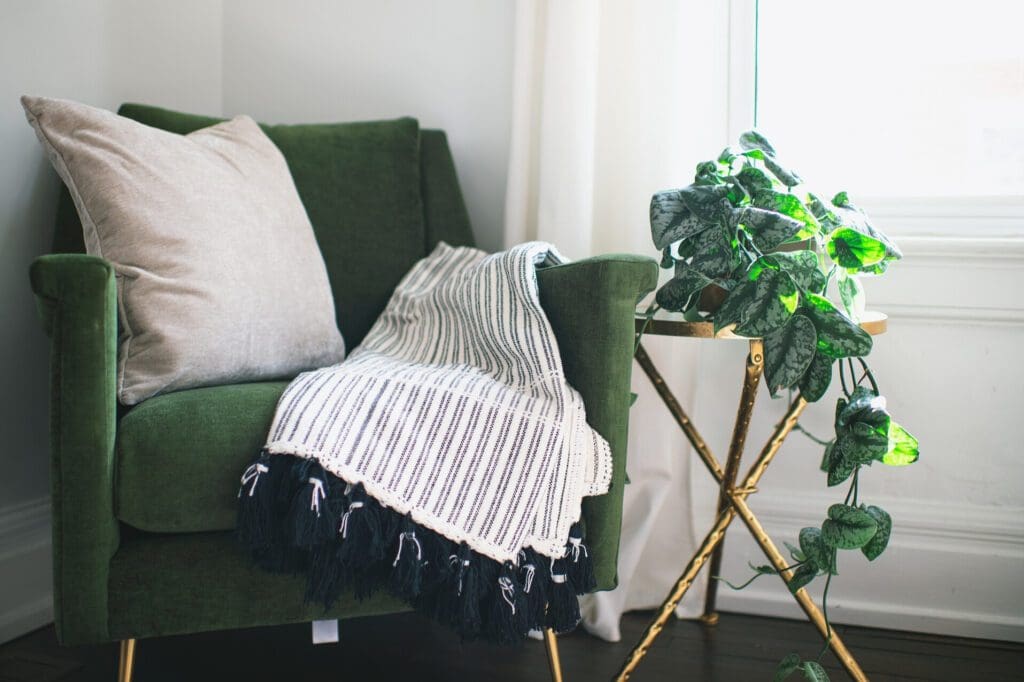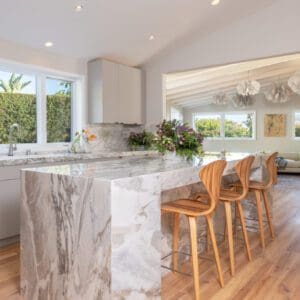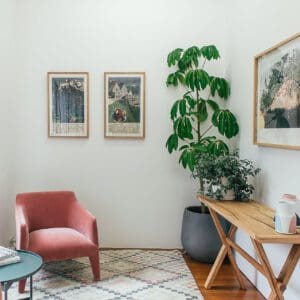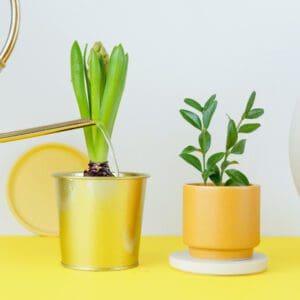In this post, we learn about biophilic interior design which goes beyond the visual aspects of interior design to consider how nature and the people involved in design support each other.
The Home Green is reader-supported and may receive a commission if you decide to make a purchase through a posted link, at no cost to you.
What is biophilic interior design?
There is a lot of research to support the fact that interacting with nature is a key ingredient in human happiness. So it makes sense that bringing natural elements into our daily lives would have a positive impact. This is, essentially, the focus of biophilic interior design.
Biophilic interior design definition
Biophilic interior design is an approach to designing indoor spaces that incorporate elements of nature to create a more harmonious and supportive environment for people. While the word sounds kinda fancy, when you break it down, it’s a pretty straightforward explanation of the concept. At its Greek root, “bios,” means life, and “philia,” means love – they come together to refer to the innate human affinity for nature.
Biophilic interior design aims to reconnect people with the natural world in the built environment. It includes various elements and principles, such as the use of:
- Natural or nature-inspired materials, colors, and shapes – Using materials like wood, stone, bamboo, and other natural elements to create a sense of connection to the outdoors is a key part of biophilic interior design. In addition, choosing color palettes, shapes, and textures that mimic those found in the natural world, such as earthy tones, organic patterns, and natural materials is important.
- Natural light and views – Biophilic interior design aims to maximize access to natural light and views of nature. This can be through large windows, skylights, strategically placed mirrors, or even through nature-inspired art and imagery.
- Plants – Incorporating living plants and greenery is a key part of biophilic interior design and provides a visual link to nature.
- Multi-sensory experiences – Designing spaces that engage the senses, including the use of scents, sounds, and textures associated with nature. This often includes things like water features, which can involve the senses in many ways.
- Sustainable and eco-friendly design – Incorporating eco-friendly and sustainable building practices and materials to reduce the environmental impact of the space.
Why is biophilic design important?
Biophilic design has the potential to positively impact both individuals, communities, and the environment. It addresses the inherent human need for connection to nature, positively impacting well-being, cognitive function, and the overall quality of life. It also promotes sustainability and has the potential to create more resilient and thriving communities. This can happen specifically through:
- Enhanced well-being – biophilic design has been shown to improve overall well-being by reducing stress, lowering blood pressure, and promoting a sense of calm and relaxation. Exposure to nature or nature-inspired elements within the built environment has positive effects on mental and emotional health.
- Increased productivity and creativity – Incorporating biophilic elements into workspaces has been associated with increased productivity, creativity, and cognitive function. People tend to perform better on tasks that require concentration and problem-solving when they have access to natural elements or views of nature.
- Promotion of sustainability – biophilic design often aligns with sustainable design principles. By incorporating natural materials, maximizing natural light, and emphasizing energy efficiency, it contributes to environmentally conscious practices and reduces the overall ecological impact of the built environment.
- Increased societal well-being – biophilic design has the potential to create more pleasant and vibrant urban spaces, contributing to a sense of community and social well-being. Well-designed public spaces with biophilic elements can encourage social interaction and community engagement.
Insight about biophilic interior design from the founder of Stacey Lapuk Interiors
Stacey Lapuk, ASID of Stacey Lapuk Interiors, specializes in using the principles of biophilic interior design to create beautiful designs. In her words:


“How we design our environments, our homes, has a measurably proven effect on our health and well-being. Incorporated into the recent science of neuroaesthetics, Biophilic Interior Design principles illustrate that when specific patterns found in nature are incorporated into our built environments, we experience happiness! The levels of our stress hormone, cortisol, along with our blood pressure and heart rate are lowered. Our serotonin, known as the “feel-good” hormone, increases. We feel more productive, and more creative.
The simple fact is that we are genetically predisposed to connect to, and live in beauty and nature.”
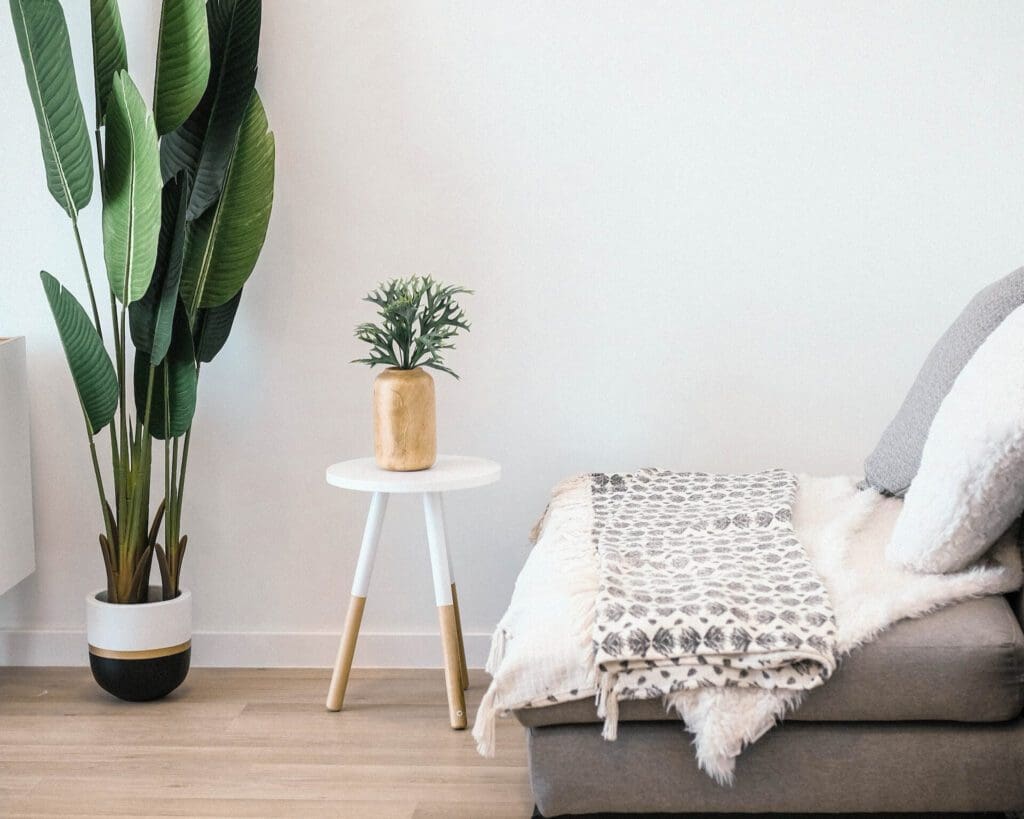

How can I incorporate biophilic interior design into my home?
Incorporating biophilic design into your home can help create a more calming, comfortable, and inviting living space. Many of the things on our list may well be things you already do intuitively and hopefully, we’ll inspire some new ideas, too. Here are 12 things to incorporate into your home:
1. Natural light
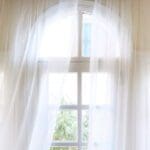

Ensure that your home gets as much natural light as possible through windows, skylights, and glass doors. Make it a habit to open up heavy curtains and other window treatments to let the light in during the day.
2. Outdoor views


Position your furniture and living spaces to take advantage of views of your garden or outdoor surroundings. If you don't have a natural view, create one with potted plants or artwork depicting nature scenes.
3. Indoor plants


Include a variety of indoor plants throughout your home. If gardening isn’t your thing, consider low-maintenance options like succulents. If you have pets or small children, make sure to research which plants are pet and child-friendly.
4. Natural materials
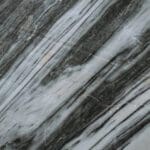

Prioritize natural materials for your home’s decor. Wood, stone, bamboo, and cork are excellent choices for flooring and furniture. For upholstery and textiles, look for natural fibers like wool, cotton, and hemp.
5. Earth tones


Choose a color scheme influenced by nature, such as earthy greens, browns, and blues. These can work well on walls, furniture, and accessories.
6. Organic shapes and patterns


Incorporate furniture and decor with organic and flowing shapes and patterns.These can include floral or leaf designs or biomorphic shapes that resemble silhouettes found in nature.
7. Water features


This recommendation can be divisive – not everyone loves the constant sound of running water. If space and your personal preference allow, consider adding a water feature like a small indoor fountain or a tabletop waterfall.
8. Art and imagery


Decorating your home with nature-inspired art, photographs, and imagery can help create a connection to the natural world.
9. Focus on all the senses


Involve all the senses – In addition to considering visual elements, engage your other senses by using scents, soft natural textures, and soothing sounds of nature.
10. Eco-friendly design


By choosing eco-friendly building materials and furnishings, including energy-efficient appliances, and LED lighting, and through minimizing waste, you’ll live more sustainably and also embrace biophilic design.
11. Optimal room layout
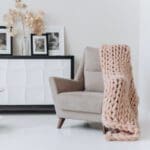

Arrange your furniture to create cozy, nature-focused spaces. For example, you could create a reading nook by a large window, surrounded by potted plants.
12. Comfortable outdoor spaces


Don’t forget about outdoor living spaces – If you have outdoor areas like a patio or balcony, create biophilic extensions of your home by adding outdoor furniture, plants, and other natural elements.
What are the 5 senses of biophilic design?
Biophilic design engages all five of the human senses to create a more immersive and satisfying connection to the natural world within the built environment. While we think most frequently of the visual elements when it comes to interior design, there can be more to creating a holistic, biophilic design. All 5 senses can be incorporated into biophilic interior design in the following ways:
- Visual – This is the most obvious connection and can be achieved through the use of natural materials, colors, patterns, and elements inspired by the outdoors. It also includes the presence of indoor plants, views of nature through windows, and nature-inspired artwork. The visual sense helps create a visual link to nature and provides aesthetic pleasure.
- Auditory – The auditory sense involves incorporating natural sounds, such as flowing water, bird songs, rustling leaves, or gentle breezes, into the design. Water features like fountains and indoor waterfalls are common ways to introduce soothing natural sounds to create a calming atmosphere and reduce stress.
- Tactile – The tactile sense is engaged through the use of natural textures, materials, and surfaces. This can include the feel of wood or stone underfoot, the texture of natural fabrics like wool or cotton, and the physical experience of touching living plants. Tactile engagement with nature can evoke a sense of comfort and grounding.
- Olfactory – The sense of smell is engaged by introducing natural scents and aromas associated with the outdoors. This can be achieved through the use of essential oils, diffusers, or the presence of fragrant plants and flowers. Natural scents can have a profound impact on mood and emotional well-being.
- Gustatory – While less commonly emphasized in biophilic design, the sense of taste can be one of the most interesting ways to incorporate biophilia into your home. For example, a biophilic kitchen design may incorporate elements that encourage outdoor cooking and dining, connecting the sense of taste with nature by using fresh ingredients grown in a garden or incorporating natural materials in kitchen design.
By engaging these five senses, biophilic design creates a multi-sensory experience that helps occupants feel more connected to nature and experience the benefits of reduced stress, improved well-being, and enhanced comfort within the built environment.
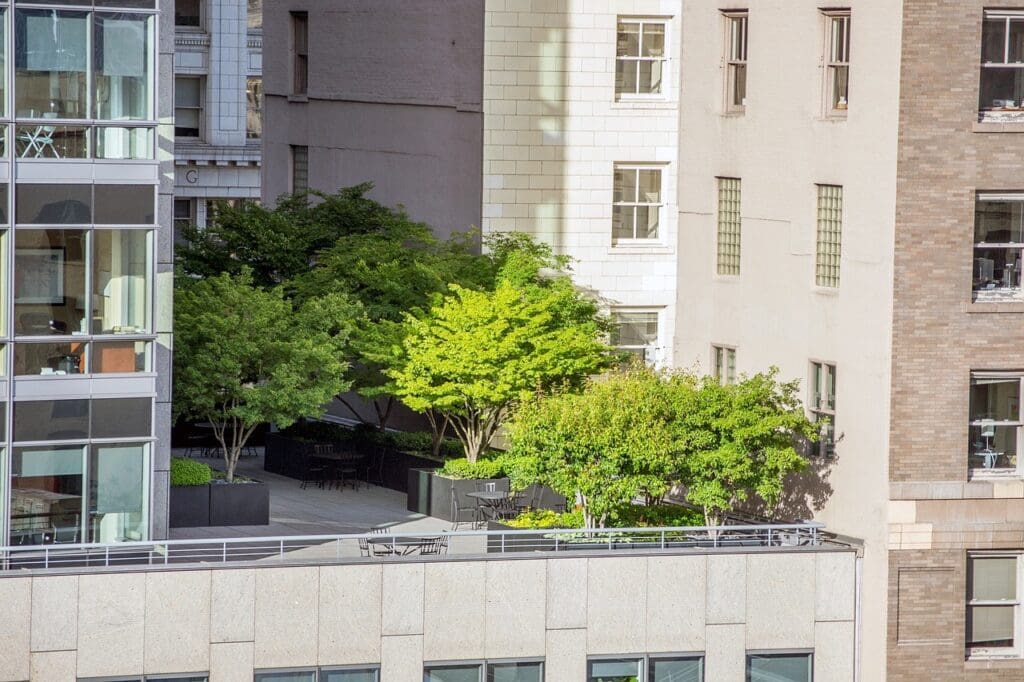

How does biophilic design overlap with sustainability?
Biophilic design inherently encourages a greater connection with and appreciation of the environment. It's principles focus on reducing energy consumption, conserving resources, enhancing indoor air quality, promoting biodiversity, and encouraging sustainable building practices. By incorporating nature into the design of interior and exterior spaces, it contributes to a more sustainable and environmentally responsible approach to architecture and urban planning.
- Energy efficiency – Biophilic design often emphasizes maximizing natural light and passive heating and cooling strategies. This reduces the need for artificial lighting and the use of HVAC systems, resulting in lower energy consumption and reduced greenhouse gas emissions. The reduced energy demand can contribute to lower carbon footprints and a smaller environmental impact.
- Indoor air quality – Air quality is an important part of biophilic interior design. Using less toxic paints, furniture, and finishings facilitates more biophilic design and is also better for the planet.
- Reduced waste – Sustainable biophilic design often involves using materials that can be recycled or repurposed. This can lead to less waste and a reduced demand for new resources, thereby lessening the environmental impact of the built environment.v
- Urban heat island effect – Urban areas tend to absorb and retain heat, creating “urban heat islands.” Biophilic design can help mitigate this effect by incorporating natural elements in the form of green roofs, vertical gardens, and other green infrastructure. These can cool urban spaces, improve air quality, and reduce the energy required for cooling buildings.
- Sustainable landscaping – Eco-friendly landscaping aligns with biophilic design in several ways. First, biophilic design elements like green spaces, gardens, and wildlife-friendly landscaping can promote local biodiversity. These features create habitats for native flora and fauna and contribute to the conservation of wildlife in urban areas. In addition, native and drought-resistant plants in landscaping can conserve water and reduces the environmental impact of landscaping.
- Sustainable communities – Biophilic design principles can be incorporated into the planning and design of urban spaces, promoting walkability, bike-friendliness, and the use of public transportation. This can reduce the reliance on personal vehicles and decrease greenhouse gas emissions at the community level.
- Eco-friendly building practices – Biophilic design often encourages the use of sustainable construction practices, such as low-impact development, green building certifications (e.g., LEED), and responsible sourcing of materials. These practices aim to reduce the environmental footprint of construction and renovation projects.
- Promotion of sustainability values – By integrating nature into the built environment, biophilic design can raise awareness and appreciation of the natural world. This, in turn, can foster a deeper commitment to sustainable living practices and environmental stewardship.
What’s the difference between biophilic design and biophilic interior design?
“Biophilic design” and “biophilic interior design” are related, but there are differences between them in terms of scope and focus. Biophilic design is a broader concept that encompasses all aspects of design, including architecture, interior design, urban planning, and landscape design. It's about creating environments that incorporate nature and natural elements into the entire built environment, from the building's architecture to its interior spaces and outdoor surroundings.
Biophilic interior design, on the other hand, is a subset of biophilic design that specifically focuses on the interior spaces of a building. Biophilic interior design is concerned with creating indoor environments that connect people with nature. It emphasizes the use of natural materials, colors, indoor plants, natural light, views of nature, and sensory elements that engage the five senses.
What’s the difference between biophilic and holistic interior design?
Holistic interior design and biophilic interior design are both design approaches that aim to create more balanced and harmonious living environments, but they focus on different aspects of design and well-being.
While both holistic interior design and biophilic interior design seek to create more harmonious and well-balanced living environments, holistic design is a broader approach that takes into account various aspects of well-being and balance, including emotional and spiritual aspects. Biophilic interior design, on the other hand, has a narrower focus on the incorporation of natural elements to improve physical and mental well-being by fostering a deeper connection to nature within interior spaces.
Is biophilic design expensive?
Like most interior design projects, biophilic interior design can vary in cost depending on things like the scale of the project, the specific design elements chosen, and the availability of resources. Some considerations include:
- Materials selection – Using natural materials, such as solid wood, stone, and high-quality natural fabrics, can be more expensive than synthetic or processed materials. However, there are often budget-friendly alternatives or sustainable options available that can help manage costs. Additionally, since higher-quality materials have the potential to last longer, you may just save money in the long run.
- Indoor plants – The cost of indoor plants can vary widely depending on the type, size, and number of plants used. Some indoor plants are affordable and easy to care for, while others, such as rare or large specimens, can be more expensive. Careful selection and/or creative sourcing can help control costs. Make friends with other plant lovers or join local horticulture groups where you may be able to work out some great plant trades.
- Natural light and views of nature – Maximizing natural light and views through window modifications or the use of skylights may involve construction and structural changes, potentially adding to the project cost. However, choosing energy-efficient windows and passive solar design principles can help balance these costs with long-term energy savings.
- Water features – Installing water features, like fountains or indoor waterfalls, can range from affordable tabletop designs to more elaborate and costly installations. The size and complexity of the water feature will influence the cost.
- DIY vs. professional design – The cost of implementing biophilic design can be influenced by whether you undertake DIY projects or hire professional designers and contractors. Doing a project yourself can save money, but will likely require more time and effort. Hiring professionals can ensure a more cohesive and expertly executed design but may come with higher design and construction costs.
It's important to note that the extent to which you implement biophilic design can vary. You can choose to incorporate a few key biophilic elements that fit your budget and design goals. Additionally, some biophilic design practices, such as the use of natural colors and patterns, may not significantly impact the overall project cost.
Ultimately, the cost of biophilic design is flexible and can be tailored to your budget and preferences. Careful planning, smart material choices, and prioritizing elements that align with your goals can help make biophilic design more affordable.
Articles related to biophilic interior design you may enjoy
Free tips and inspiration in your inbox
Enter your email address below to receive the latest news from The Home Green.

